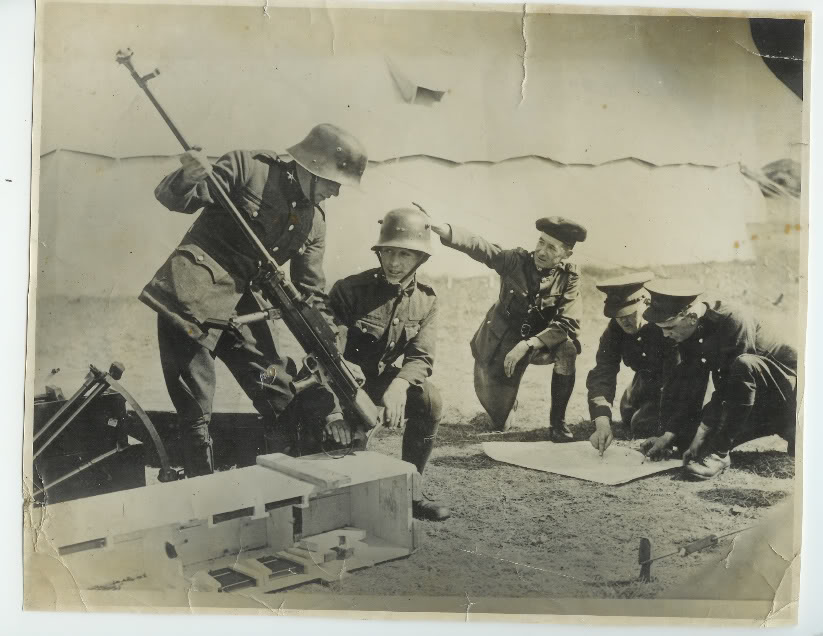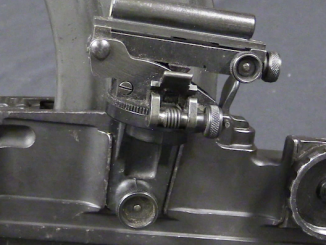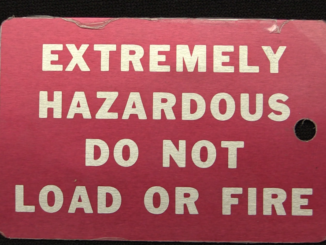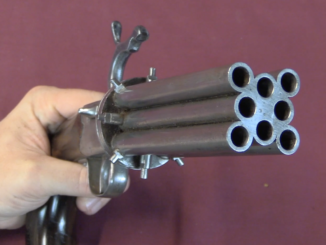
The Republic of Ireland opted to copy the German WWI Stahlhelm design rather than use British Brodie-style helmets. Until 1940, anyway, and I think it’s pretty clear why they changed. The rifle here, of course, is a MkI Boys Anti-Tank Rifle, which would prove to be passably effective only for about the first 18 months of the war in Europe.




Which helmet was the more effective?
The Stahlhelm was more effective in my opinion, better side and back protection.
The Irish version was made by Vickers and used thinner steel, so the German helmet was far better.
Clearly not the Brodie helmet. There was a reason the US PASGT Kevlar helmet that replaced the M1 helmet starting in the ’80’s somewhat copied the lines of the Stalhelm (later versions, not the M15 pictured above). It provided superior neck and ear protection compared to Allied helmets. None of the helmets of the period would be effective against rifle bullets, and they would stop pistol bullets only at longer ranges. Their primary purpose was to provide protection from overhead fragmentation from artillery shells and other explosives.
The French Adrian helmet, which wasn’t as tough as the Brodie, was at least inexpensive in comparison and easier to manufacture in bulk (and probably easier to customize). Adrian got the idea for modern head protection after a poilu allegedly survived artillery bombardment by yanking a heavy cooking pot over his head in panic. First came “skull caps” under the kepi, then came bigger iron hats, and then came the full-fledged Adrian (which became popular in Depression Era Europe, if I’m not mistaken). The Adrian was phased out because it wasn’t adaptable to multiple roles in the latter half of the twentieth century and because surplus M1’s and similar helmets were everywhere.
The M15 and M26 Adrian helmets continued in use amongst colonial and service support troops in Indochina, but most units (airborne, especially) used M1 helmets with regular, M1C, or locally-made liner chin straps. These were received as part of MAP from the US, along with massive amounts of US uniforms- HBT, “frogskin” camo- web gear, and M43 (M1942, to a lesser extent) boots, not to mention weaponry. The Mle. 51 replaced the Adrian helmets by the time the war was over, and then supplanted the M1 in French service in the first couple years in Algeria. The Mle. 56 helmet was a Mle. 51 shell with a different strap arrangement for airborne use (the strap sucked, by the way).
Unless the heat treating was much more tedious, I cannot see how a Brodie helmet would be more complicated to manufacture than the Adrian.
Still in use, 100 years after: https://upload.wikimedia.org/wikipedia/commons/e/ee/BSPP_section_Bastille_Day_2008.jpg
by the Paris Fire Brigade (only for parades and as traditional traditional headgear) wich is technically a unit of the French Army’s Engineering Arm since napoleonic times.
The Irish wearing those helmets during WW2 won’t have mattered, as they remained neutral in that war.
So neutral that the head of the government sent an official condolence to Germany for the death of Hitler as one would for any head of state.
Dev’s sympathy for national socialism ran a little deeper than the condolences letter.
An example of those sympathies was the number of Jews granted asylum in the free state between 1933 and 45.
Forty individuals.
There were contingency plans, should things have gone further than the Luftwaffe bombing of the dairy in the County Wexford village of Campile: resist for 24hours then call Churchill
Don’t think it would have been advisable to have worn one of those helmets on the border with Northern Ireland unless it was painted green…
I didn’t think of that, but the Brits would have gotten used to it.
I’d guess England gave the Irish these replacement helmets so that if the German did send a few troops into Ireland they would be more easily noticed.
Or maybe the Irish switched helmets so that if the Germans invaded England and it went well for Germany, the Irish could more easily move into N. Ireland without alarming England until it was to late for England to do anything.
It was a good thing for the Brits that they had somewhat settled things with the Irish a bit before WW2. A two front war for them would have been hard.
Bud of mine had a Boyes converted to 50 cal from the original .55 caliber…not only was the ammunition easier to find, but at .55 it became a DD according to the JBT ATF crowd
IIRC, The Taiwanese used the Boyes to snip at communist troops on the islands of either Quemoy or Matsu…I remember reading something to that effect years ago…before Google
I KNEW I was right….did a Google of ‘Boyes Anti-tank rifle Taiwan’ and found this:
https://books.google.com/books?id=U1FsIJ8YvFUC&pg=PA131&lpg=PA131&dq=boyes+.55+anti+tank+rifle+taiwan&source=bl&ots=Xag8xXLScW&sig=WUyoKf9uzhAyYa_0ZzI5B6OD1u4&hl=en&sa=X&ved=0CEIQ6AEwCGoVChMIvdzo6-X2xgIVhyceCh1SQgn4#v=onepage&q=boyes%20.55%20anti%20tank%20rifle%20taiwan&f=false
Yep I’ve got that book. It gives an account of Ralph T Walker (a US gunsmith) helping out Chinese Nationalist forces in Formosa/Taiwan. There was a small island held by Nationalists under artillery cover from Quemoy which was just a 1100 yard stretch of shallow water from a communist held island. Crosswinds made .30cal unfeasible and the sound of incoming artillery gave the enemy time to move to cover. He noticed in their very full inventry a number of Boys rifles but no ammo so he adapted them to .50cal and fitted a 20power spotting scope designed for tank use on a homemade mount. They made 12 in total and selected the physically biggest and best shots to train in their use. He mentions the groups they shot were 2feet long. He doesn’t specify what range that was at but he said it was adequate so presumeably he means at the intended range. Anyhow these were used to engage Chi-Com soldiers who didn’t the shots being fired until they were taking hits.
He remarks that about a dozen Chicoms “had their swimming privileges revoked…permanently.”
“Take that, Commies! We’re going to annoy you to death if you don’t come down here!”
“We’ll get even… SOMEHOW!”
Perhaps the Battle of Guningtou was more amusing when it turned out a Nationalist LST, Chung Lung, was anchored near the Communist landing sites just because the crew was smuggling Taiwanese brown sugar and was waiting for enough peanut oil from Kinmen Island to declare the illegal transaction complete, which meant it did not leave on schedule. When the Chung Lung’s crewmen saw the Communist boats stopping on the beach, they waited until the PLA forces exited their impromptu landing craft and then smashed the boats with the ships anti-air guns.
The Communists who did get away from the beach ran into a trio of ROC M5A1 Stuarts, one of them still undergoing repairs. Unfortunately for the attackers, all three tanks were still able to shoot them. Soon, more tanks came and steamrolled the charging Communists…
“adapted them to .50cal”
Why British Army decides to design their own .55 cal anti-tank cartridge rather than adopting American .50 Browning?
They tried a .50 caliber round first, but didn’t get satisfactory penetration and upped it to .55 caliber.
The unusual grip angle on the Boys has puzzled me for years. Does anybody have a clue as to why they did that?
I think it just makes for a comfortable grip. I’ll be look at one at RIA next week and that’s something I am curious about.
More comfortable in prone position especially if you used something to absorb the recoil.
You guys may be right, here I was imagining a seated position with the butt against a tire and the stock over your shoulder so you reached up to grab the grip. But your descriptions seem ok with my body geometry, assuming I am not getting walloped.
The Boys was designed to be fired from the prone position due to its weight. It either had a bipod, an odd sort of monopod, or was just rested across a convenient fallen log or whatever. (Remember, it was intended for use in NW Europe.)
If you lie prone behind this monster, and snug it up to your shoulder, you quickly realize that if the pistol grip were almost vertical like a Bren’s, you would have to “curl” your wrist downward relative to your forearm to get a proper hold on said grip.
The forward-raked grip allows you to keep your wrist straight. Considering that this basically a sniping/ambush weapon, no matter what the target (tank, BF-109 sitting fueled on an airfield, Gauleiter in a chateau 1200 meters downrange, whatever), you could expect to spend a lot of time waiting for the shot. So anything that reduces fatigue is a good thing.
Having your wrist “cocked down” for any length of time both causes fatigue, and just plain hurts.
The Boys make look odd, but a lot of very careful thought went into its design. Form follows function, as they say. And ergonomics was something that was recognized as important back then, even if it hadn’t actually been given a name yet.
cheers
eon
“rested across a convenient fallen log or whatever”
If you are interesed in Boys AT rifle operation you can see training movie here:
https://www.youtube.com/watch?v=CnhlD0HZAm4
which describe “The Anti-Tank Rifle(Boys Mk-I) is small and highly portable. It can be easily camouflaged and concealed on almost any type of terrain.”
Notice the early inverted T-shape monopod.
The pistol grip was angled forward so that on recoil, which was considerable, your hand would move down the grip and not up, which often leads to bruising in the area between your thumb and forefinger. If you have ever fired an early FG42 you will know all about this..!
The Boyes also had a “sabre” grip on the butt for the left hand to hold, much like the Mk 1 BREN.
Might have been obsolete in Europe but the Boys was still very effective against Japanese Tanks for the whole war
Even if newer German tanks enter production and service that doesn’t matter that older disappear. Notice that last “classical” (earlier than “overlapping wheel”) version of Panzer II – the Ausf. F was produced to December 1942, despite being woefully outclassed by contemporary other nation tank designs. Don’t forget about other armoured vehicles not being tanks which were immune to rifle fire, but not AT rifle, for example Sd.Kfz. 250 troop carrier.
Also notice that German Thoma-Schürzen (often simply called Schürzen) were not introduced not against HEAT artillery shells, but rather Soviet AT rifles (self-loading PTRS and semi-auto PTRD) as they can penetrate weak side armour of German tanks deployed during Operation Barbarossa (PTRS with BS-41 bullet can penetrate 45mm plate at 300 meters at 0 deg. angle [Russian style – 0 deg. mean vertical plate, unlike German style where 90 deg. mean vertical plate])
The Panzer III F was used mainly for reconnaissance and infantry support on secondary sections of the front. The Soviets also had the T-60, which was used similarly, so calling the Pz III F “woefully inadequate” is a little unfair. The US Army used the M5 Stuart until the end of the war in Europe, even though both its armor and main gun were clearly obsolescent by 1944 and it wasn’t even particularly fast.
The Soviet 14.5mm AT rifles with the BS-41 tungsten-carbide core penetrator bullet were effective against the side hull armor of all Panzer III and Panzer IV chassis vehicles at short ranges, not just the ones deployed during Operation Barbarossa.
There was also a tungsten-carbide core bullet developed for the Boys in 1942, but it was never adopted, since the price was relatively high and performance not good enough by mid-war standards.
The .55 Mark I Boys held by Taiwan were J.Inglis (Canada)constructed models, sent to China in 1942-43 as Canada’s contribution to the KMT war effort (along with Canadian Made .55 ammo, 1,000 Rifles No4 MarkI* (Long Branch) and Sten Guns Mark II (also LB) and ammunition to suit –oops, almost forgot the “Chinese” HP-35 Brownings as well (shoulder stock and Long range sights). The Taiwanese Boys are the ones taken there in 1949 from Chungking etc.
I have seen the No.4 rifles in the Shanghai Film Corporation Armoury, and some of the Stens were converted to 7,62×25 in the 1950s, and over-stamped in Chinese on the Mag well. (seen one in a collection in Australia).
Doc AV
One China-man I knew opined that KMT troops looked just like Nazis, save for their Asiatic faces.
Fresh from the factory, where is the nearest Cruiser Mk IV A13…eh I mean the nearest Panzer II, of course…:D
What was the reason Americans used their helmets (presumably M1) without chin strap? Were they(those helmets) not easily blown away or even lost in this fashion? Or were they sooo deep that it was not necessary to strap them?
Many soldiers of the time bought into the myth that a blast’s concussion would knock the helmet off of their head and take their head with it, or at least snap their neck. The T1 pressure release fastener was introduced to the M1 helmet for this reason.
Mostly, it was a matter of comfort. I find any helmet strap system short of an Ops Core X-Nape on an ACH to be hellaciously uncomfortable for any longer than five minutes. As long as the nape strap on an M1 is tightened properly, the helmet will stay relatively in place.
Also, WW2-era knife use doctrine prescribed stealthily attacking a sentry or other such target from behind, grabbing a helmet or the head, tilting that back, throwing the target off balance, and either/both slitting the throat or stabbing the abdomen. Having the helmet strapped would allow the assailant to have a bit of an easier time controlling the movement of the head, whereas leaving it unstrapped would negate that advantage or even buy an extra split second while the assailant figures out what to do with the helmet now in his hand.
Yes the obsolete, ineffective and generally useless Boys AT rifle.
It is interesting that every army now has a similar rifle in use as an “anti material” weapon.
IIRC there were incidents on the Ulster border caused by the Irish M27 helmet. The Irish refused to adopt the “Brodie” because it was too English but had to buy their Hun hats from Vickers, England.
Talking about friendly fire potential, the German-style helmets were used all-over Europe after WW1, because they were sold dirt-cheap by the ton by the French, Italians and British. Why the Irish were buying their ‘Hun-hats’ from the Vickers, I don’t know – in 1920s they were a-plenty as surplus, both German and Austrian ones. In Poland, e.g. they were being worn by the Police (with HUGE silver eagles worn on the front), but quite a number of military units as well. In 1939 these were mostly phased out by the Polish original design of the wz.31 Donica (Flowerpot) – much like the later Soviet M40 or US M1. One military unit retained them however – the 16th Motorized Cavalry Brigade, Poland’s only battle-ready tank and motorized unit.
Hun-hats were also worn by the Finns (but that doesn’t count – it’s hard to find a style of helmet that the Suomen Armeija DID NOT use, save for the Brody), who also were the only Axis country to have been officially sold the Boys rifles. BTW, they still had US Army attaches as maneuver observers in 1943!
Finland was not allied to Germany either officially or unofficially when the Boys rifles were sold to Finland. In fact at the time Germany was honoring their alliance with the Soviet Union and blocked transit of weapons through Germany to Finland. Finland signed the Anti-Comintern Pact in November 1941. However, most Finnish historians maintain that there was never a formal military alliance between Germany and Finland, since the Anti-Comintern Pact was political, rather than military, in nature and Finland refused to sign the Tripartite Pact, which was clearly military.
As for the German-style helmets; to my knowledge Finland was the only country which continued to use that style of steel helmets long after WW2. In 1955 the Finnish Army even ordered 50,000 new helmets from West Germany, which were almost identical to the German M35/40 helmets but of course lacked the Nazi markings (they were probably made using the same blueprints). In addition authentic WW2 German helmets and Hungarian M38 helmets (which were similar to German M35) continued to be warehoused until 2006. In the 1980s the M55 helmet was still widely used, although the Finnish firm Fiskars had started to manufacture new steel helmets roughly similar to the US M1 for the Finnish army in 1962. The German-style helmets were finallysuperceded for the most part by introduction of a new composite helmet in the 1990’s, although the last sightings are from 2005, only a year before they were officially removed from service. The German-style helmets were kept warehoused longer than captured Soviet M40 helmets, which were not used for peacetime service, although they were of course very common sight from 1941 to 1945.